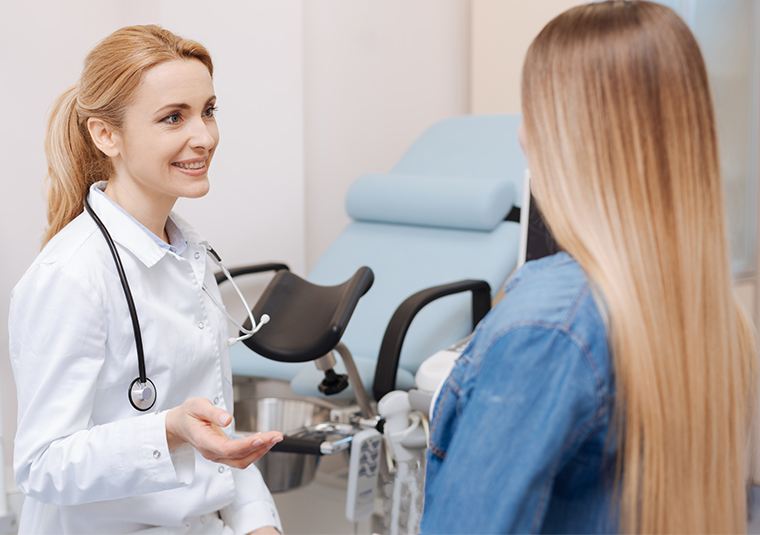Most women would like to stay young, beautiful and healthy for as long as possible, but in their everyday lives they often do not pay attention to their bodies’ very important pelvic floor muscles, which are responsible for controlling the bladder (especially when laughing, coughing or engaging in strenuous physical activity), defecation and vaginal functions, and which play an important role in childbirth and one's sex life.
Weakening of the pelvic floor muscles may cause embarrassment and diminished quality of life for women of all ages!
Biofeedback therapy offers a unique opportunity to effectively strengthen and recondition the pelvic floor muscles using a multifunctional high-tech therapeutic and prophylactic system, Callibri BeFit PRO.
The operating principle of the system is to identify the causes and select a treatment program using the biofeedback (BFB) method. The procedure is performed in a comfortable, private setting in a gynecological or special BFB office.
General indications:
- urinary incontinence prevention and treatment;
- pelvic organ prolapse prevention and treatment;
- pregnancy and childbirth conditioning;
- postpartum reconditioning;
- pelvic pain syndrome;
- sexual dysfunction management and treatment.
Biofeedback is a fundamentally new approach to regulating the functions and condition of the human body, and is widely used in urogynecology for diagnostic, prophylactic and therapeutic purposes.
Biofeedback therapy is a modern wellness technique based on the concept of adaptive biofeedback. The main objective of biofeedback in urogynecology is to teach the patient self-regulation and self-control skills, and the Callibri BeFit PRO device allows the patient to access information that is ordinarily not perceived.
This method has gained wide recognition in different parts of the world and has a solid scientific base in the Russian Federation.
However, most physicians and patients are not familiar with biofeedback treatment. The information below provides insight into the general principles of innovative biofeedback techniques and their application in the fields of gynecology and urology.
MUSCLES OF THE LESSER PELVIS IN FEMALES
The female pelvic organs (uterus, vagina, ovaries, rectum and bladder) are located on top of the pelvic floor muscles. Decreased or increased tone of these muscles may lead to the following problems:
- genital tract injuries or lacerations during childbirth;
- uterine or vaginal prolapse after childbirth, occasionally co-occurring with bladder, ovarian or rectal prolapse;
- sexual dysfunction presenting as reduced vaginal sensitivity or inability to orgasm;
- urinary incontinence during athletic activities, coughing or sneezing;
- recurrent urinary and genital tract infections.
It is necessary to distinguish between vaginal and pelvic floor muscles. The former are made of a thin layer (1–2 mm) of smooth tissue and cannot be consciously contracted. One can be taught to contract the pelvic floor muscles intentionally; in genital prolapse, these are the muscles to train.
A variety of methods for normalizing muscle tone of the lesser pelvis have been developed: IMbuilding (intimate muscle or womb building), sexercise, intimate fitness and Kegel balls.
Biofeedback therapy is one of the more innovative and effective techniques to recondition the muscles.
WHAT IS BIOFEEDBACK THERAPY?
The application of this method involves the self-regulation of one's organ and system performance with the assistance of biofeedback received from sensors attached to the body.
Special sensors record the condition and physiological parameters (EEG, EMG, ECG, etc.) of the human body and transmit them to a computer program. The software transforms the signals into audio or video format, which is easily perceived by the individual, who can use it to develop muscle memory and recognize and strengthen the ability to use the muscles correctly.
Biofeedback training is a modern method for correcting a number of disorders.
Urinary dysfunction, speech defects and panic attacks are just some of the disorders that can be treated with the help of biofeedback.
In some countries, biofeedback therapy for gynecological disorders must be covered by medical insurance.
BIOFEEDBACK THERAPY IN GYNECOLOGY
The objective of biofeedback training in gynecology is to normalize pelvic floor muscle tone. Tensing these muscles for training purposes is not easy. Patients can rely only on their own sensations, which can sometimes be deceiving. Instead of being beneficial, exercises, when performed incorrectly, can cause harm and exacerbate the problem.
Biofeedback training enables the individual to develop the ability to use the pelvic floor muscles correctly within a relatively short time.
The procedure involves the following:
- A special intracavitary electrode is placed intravaginally without causing any pain or discomfort.
- A myogram is generated in the process of contraction and relaxation of the «intimate» muscles by means of a special Callibri sensor connected to the vaginal electrode with a cable. Signal parameters are processed and transmitted via Bluetooth to the physician’s computer. Miniature sensors are attached to the patient’s body to register contractions of the pelvic floor, gluteal, abdominal and hip muscles.
- Once the software processes the sensor data, the information is displayed on a screen. This allows the patient to visually track which muscles she contracted and which she did not.
- In this way, a connection is established between the sensation experienced during muscle tensing and the image on the screen.
- At the same time, the physician monitors the patient’s muscle activity via a graphical display on a separate screen. This allows for the coordination and correction of the patient's muscle activity throughout the session.
As a result, the patient develops the ability to control the specific muscles that restore the normal position of the internal organs.
Approximately 15 sessions are necessary to develop this ability. If the patient is in good physical shape, even fewer (8–10 sessions) may be required.
BIOFEEDBACK EQUIPMENT REQUIRED FOR GYNECOLOGY
The professional medical biofeedback system Callibri BeFit PRO was developed for biofeedback training for urogynecological problems at clinics and rehabilitation facilities. The system allows for monitoring and regulating pelvic muscle exercises during either a single session or the entire course of treatment.

Medical device

Non-medical device
To receive biofeedback therapy, a referral from a medical specialist (urologist, gynecologist, sexologist or proctologist) is required to ensure the absence of contraindications. The procedure can be performed by a physician or specially trained nurse. (Training for Callibri BeFit PRO operators is managed by the system’s manufacturer.)
It is very important to continue training after biofeedback therapy to maintain the acquired skills.
Callibri BeFit, a special training device developed for home use, enables continuous independent biofeedback training after specialist consultation.
The device is controlled by a mobile application, making it very convenient for home use.
HOME TRAINER OPERATING PRINCIPLE
- The trainer consists of an intracavitary electrode (or probe), which is placed intravaginally without causing any pain or discomfort. In the process of contraction and relaxation of the «intimate» muscles, a special Callibri sensor connected to the vaginal electrode by a cable generates a myogram. The signal parameters are processed and transmitted via Bluetooth to the mobile phone application.
- The application contains several program options, one of which is selected according to the problem.
- The Callibri BeFit trainer works on the basis of the biofeedback method, which means that the degree of pelvic floor muscle contraction is displayed as feedback on the mobile phone screen, like a game.
- In the process of training (contracting and relaxing) these muscles according to a specific methodology, the user controls the game on her smartphone, which allows her to monitor and manage the training process.
TRAINING RESULTS
- the pelvic floor muscles are noticeably strengthened;
- the blood circulation in tissues and muscles is improved;
- the ability to use the pelvic floor muscles correctly is developed in a relatively short time;
- the ability to control the specific muscles that restore the normal position of the internal organs is acquired.
CONTRAINDICATIONS
Biofeedback training has no absolute contraindications; however, as with any therapy, there are certain recommendations:
- Biofeedback training can be performed even during pregnancy but with mandatory physician supervision due to the potential for hypersthenia of the uterus or harm to the fetus.
- Biofeedback therapy should not be performed earlier than 4–6 weeks after childbirth. During this period, lochia (heavy flow of blood, mucus and tissue) is discharged from the genital tract, preventing the secure placement of the sensor.
- Patients must be examined for the presence of neoplasms (benign or malignant).
- Biofeedback training should not be performed within the 10-week postoperative period after pelvic organ surgery.
